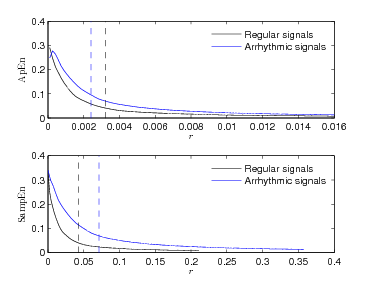Section: New Results
Characterizing the dynamics of cardiac arrhythmia
The dynamics of cardiac arrhythmia is quite complex. Better understanding its mechanism can help to improve the treatment. In vitro cultures of cardiac cells which has similar parameters as cell of human's heart represent valuable tool and model to study this issue.
by Complexity Analysis
Participants : Binbin Xu, Oriol Pont.
Stochastic approaches provide a type of methods to characterize cardiac arrhythmia, aimed at quantifying the statistical properties of the time series. Complexity analysis such as Approximate Entropy (ApEn) and Sample Entropy (SampEn), are particularly useful to analyze time series in electro-cardiology in which the signals are characterized by their high regularity in normal condition in contrast to irregularity in pathological cases. It is shown that ApEn and SampEn can not only serve as a discrimination index, but also provide another parameter which showed doubling phenomenon. It proves in other terms that bifurcation happens in case arrhythmia. See figure 1 .
|
by Phase Space Reconstruction
Participants : Oriol Pont, Binbin Xu.
References: [19] , [40] , [22] .
Phase space reconstructions of electrical field potential signals in normal and arrhythmic cases are performed by characterizing the nonlinearity of these signals. The phase space reconstructions highlight attractors, whose dimension reveals that they are strange, depicting a deterministic dynamics of chaotic nature in the in vitro model. The electrical activity of the heart consists of nonlinear interactions emerging as a complex system. Electrocardiographic imaging provides a full spatiotemporal picture of the electric potential on the human epicardium. Rhythm reflects the connection topology of the pacemaker cells driving it. Hence, characterizing the attractors as nonlinear, effective dynamics can capture the key parameters without imposing any particular microscopic model on the empirical signals. A dynamic phase-space reconstruction from an appropriate embedding can be made robust and numerically stable with the methods developed in the team. With these, we have been able to show how both the phase-space descriptors and those of the a priori unrelated singularity analysis are able to highlight the arrhythmogenic areas on cases of atrial fibrillation. See figure 2 .





